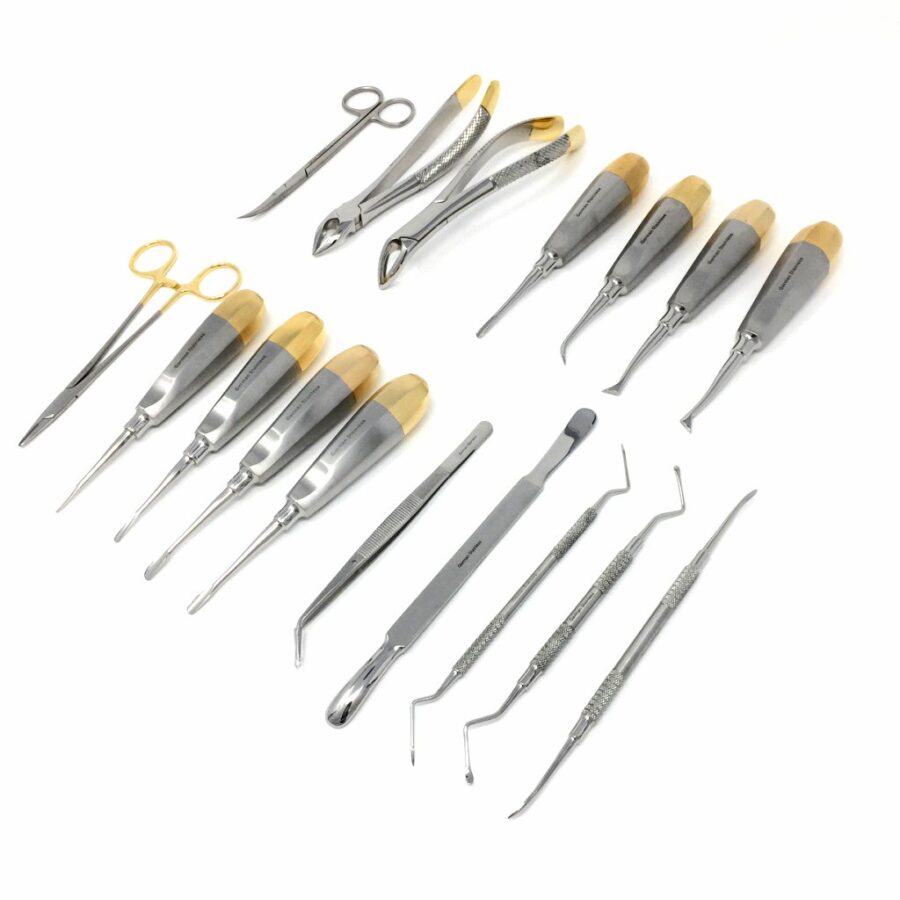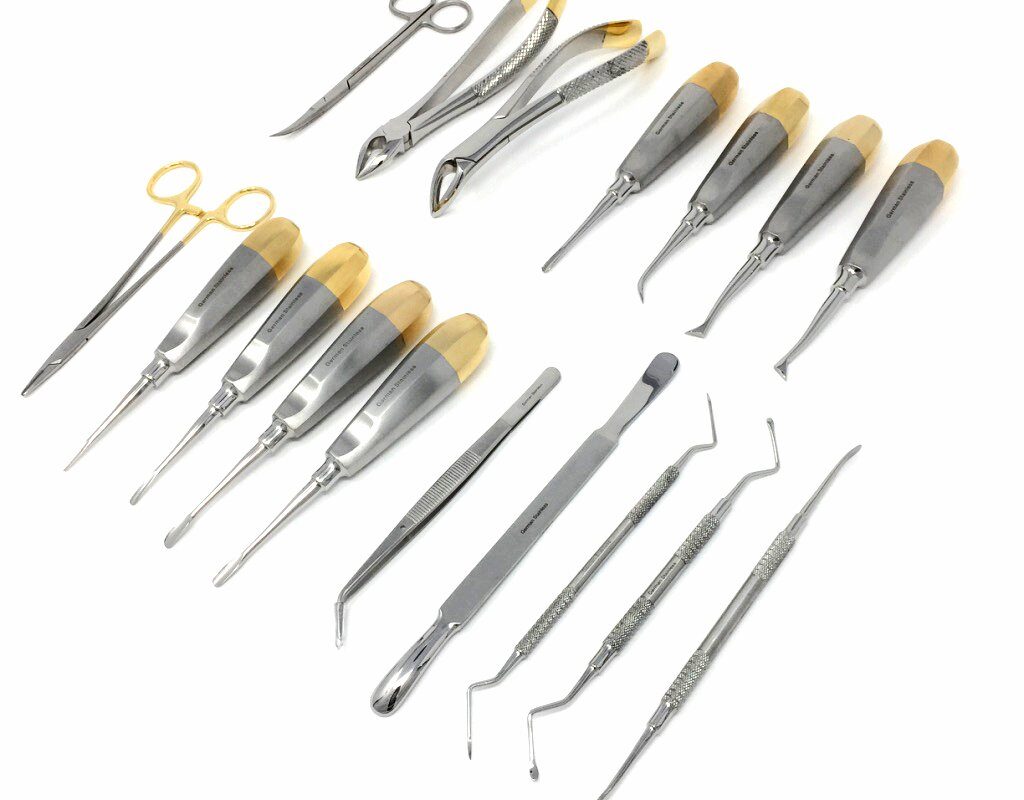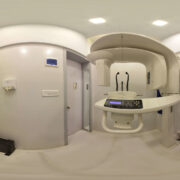Material & Instrument : The dentistry wizardry is revealed in the quiet sanctuary of a dental clinic, where the sound of drills and lights blend to produce a unique song. Have you ever thought about the instruments and materials used by the dental sorcerer while you lie back in the chair, your senses keen? The mastermind of Royal Dental Clinics, Dr. Chirag Chamria, kindly shares the trade secrets with you and takes you on an exciting tour through the world of instrument and material identification.
Essential Instruments used in Dentistry
Diagnostic Instruments
Mouth Mirror: The mouth mirror is a tiny, angled mirror that is used to view and reach various parts of the mouth. It facilitates the examination of the teeth and gums, enabling dentists to identify problems that might not be immediately apparent.
Straight Probe: This little tool aids in the detection of cavities and surface abnormalities in teeth by dentists. Its pointed end makes accurate probing possible, which helps to reveal any dental issues.

Excavator: To remove tooth structure that has been damaged or decaying, excavators are necessary. They enable dentists to accurately dig and prepare the tooth for restoration since they are available in a variety of forms and sizes.
TweezerDespite their apparent simplicity, tweezers are quite useful for handling small materials and objects during dental treatments. They improve control and precision, guaranteeing that delicate jobs are executed with grace.
Root Canal Treatment | Material & Instrument
Burs and K-Files: During root canal therapy, burs and K-files are utilized in tandem. Burs aid in the contouring and preparation of the access cavity, and K-files are used to thoroughly remove contaminated tissue by navigating and cleaning the complex root canals.
Rotary Files: Root canals may be cleaned and shaped more precisely and efficiently with the help of this motorised equipment. They improve the root canal process’s precision and speed.
Endomotor: During root canal therapy, an endomotor is an electrical device that regulates the torque and speed of rotating tools. It guarantees peak performance and gives the dentist more authority over the process.
Rc Help: During root canal therapy, Rc Help is a solution that is used to improve the root canal system’s cleansing and disinfection.
Rc Salt: To properly irrigate and disinfect the root canals, RC salt is another solution used in root canal treatments.
Gutta Percha (GP): After the diseased pulp is removed, the cleansed root canals are filled and sealed with this rubber-like substance. It makes sure the seal is hermetic, which stops reinfection.
Zinc Oxide: During root canal treatments, zinc oxide is frequently utilized as a temporary sealing substance to offer protection until the full repair is finished.

Formocresol: Because of its pulpotomy-inducing and antibacterial qualities, Formocresol is a medication used in dentistry operations, particularly root canal therapy.
24 Powders and Liquids: Serving as a catalyst for certain processes, the combination of 24 powder and liquid is utilised for a number of dental operations, including root canal treatments.
Restorative Material
Composite Restoration
- Etching gel is used to prepare the tooth surface for bonding by creating micro-pores. It enhances the adhesion of restorative materials to the tooth structure.
- Bonding agents are applied after etching to facilitate the bonding of restorative materials to the tooth surface, ensuring a durable and stable restoration.
- Composite is a tooth-colored restorative material used for filling cavities and restoring the natural appearance of teeth. It bonds well with tooth structure and provides excellent aesthetics.
GIC Restoration
Type IX Glass Ionomer Cement (GIC) is a restorative material known for its fluoride release and biocompatibility. It is commonly used for certain types of dental restorations.
Luting Material
Type I GIC: Type I glass ionomer cement (GIC) is a luting material commonly used for cementing crowns, bridges, and other dental restorations. It forms a chemical bond with the tooth structure, providing a stable and durable connection.
Extraction
Moon’s probe is a specialized instrument used during dental extractions to explore and assess the depth of periodontal pockets and identify potential complications.
Forceps are essential for gripping and extracting teeth. They come in various shapes and sizes, each designed for specific tooth types and locations in the mouth.
An elevator is used to luxate or loosen teeth within the socket before extraction. It aids in atraumatic tooth removal, minimizing trauma to surrounding tissues.
Overview of Modern Identification Technologies
Modern dentistry has embraced cutting-edge identification technologies that surpass conventional techniques in its quest for speed and precision. Two remarkable innovations have emerged in the field of instrument and material identification, propelled by innovation:
RFID Technology for Tracking Instruments
The tracking and administration of dental tools have undergone a radical transformation because of RFID (radio-frequency identification) technology. Small RFID tags are used in this system, which is affixed to every tool and enables real-time tracking and monitoring across the dental clinic.
Accuracy in Inventory Management
Dental practitioners may maintain an exacting log of their instrument inventory with the use of RFID. The tags are easily read to yield real-time information about each instrument’s location. This simplifies the inventory management process and reduces the chance of misplacing anything.
Improved Sterilization Assurance
RFID-enabled tracking devices make sure that every item goes through the required sterilization processes. In order to improve infection control procedures in the dental context, the system may be configured to notify personnel if an instrument has not been adequately sterilized.
Time-Efficient Workflow
By eliminating the need to spend time looking for certain tools, RFID technology greatly increases the efficiency of dental treatments. With the correct instruments at their disposal, dentists can concentrate more on providing care for their patients.
Imaging Methods and Spectroscopy for Material Identification
In dentistry, material identification now has a new dimension thanks to spectroscopy and imaging techniques. These techniques examine and distinguish between different dental materials by using the principles of light absorption, reflection, and emission.
Accurate Material Composition Analysis
Spectroscopy allows for a detailed analysis of the composition of dental materials. By shining light on a material and analyzing the reflected or emitted light, dentists can obtain precise information about its composition. This is particularly crucial in restorative procedures, where the choice of material impacts the restoration’s longevity.
Non-Invasive Material Identification
Unlike traditional methods that may involve destructive testing, spectroscopy and imaging techniques are non-invasive. Dentists can identify materials without altering or damaging them, preserving the integrity of restorations and reducing the need for unnecessary replacements.
Real-Time Chairside Diagnosis
The speed at which spectroscopy and imaging technologies operate allows for real-time chairside diagnosis. Dentists can swiftly determine the nature of a material, ensuring that treatment plans can be adjusted promptly based on accurate information.
Conclusion
The secret to unlocking smiles in the magical realm of dental wizardry is instrument and material identification. With his commitment to his profession, Dr. Chirag Chamria offers his patients not just dental care but also an education into the painstaking craftsmanship of oral health. Thus, the next time you find yourself in the dentist chair, keep in mind that a wizard and a symphony of tools and materials are working together to build your ideal smile behind the magic wand.






